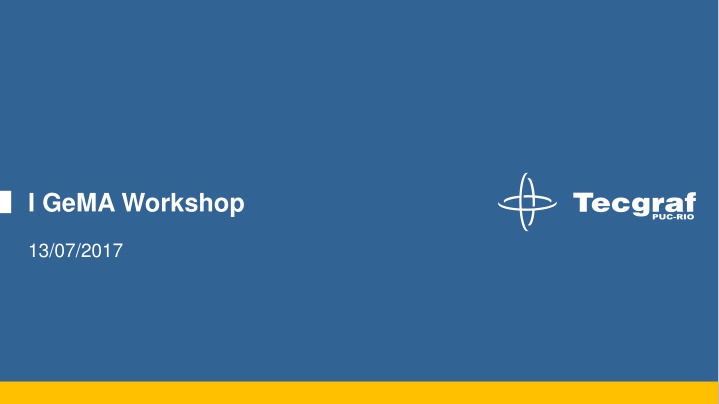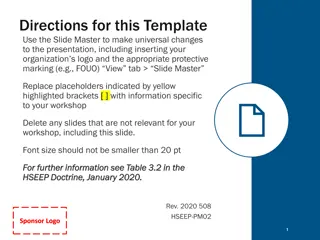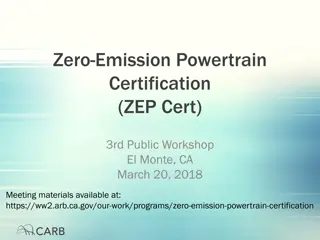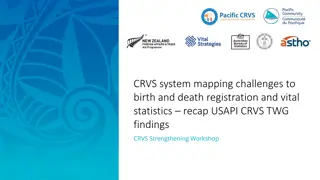I GeMA Workshop
The GeMA Workshop held on 13th July 2017 covered various topics such as introduction to the GeMA framework, building simulation models, orchestration, and more. The workshop provided insights into Geo Modelling Analysis Framework and its applications in the field. It showcased the capabilities of GeMA and the user types involved in its utilization.
Download Presentation

Please find below an Image/Link to download the presentation.
The content on the website is provided AS IS for your information and personal use only. It may not be sold, licensed, or shared on other websites without obtaining consent from the author.If you encounter any issues during the download, it is possible that the publisher has removed the file from their server.
You are allowed to download the files provided on this website for personal or commercial use, subject to the condition that they are used lawfully. All files are the property of their respective owners.
The content on the website is provided AS IS for your information and personal use only. It may not be sold, licensed, or shared on other websites without obtaining consent from the author.
E N D
Presentation Transcript
I GeMA Workshop 13/07/2017
Schedule 10:00 Introduction to the GeMA framework (Carlos Augusto) 11:00 Building simulation models (Carlos Augusto, Nilthson, Cristian) 12:00 Lunch break 13:00 Orchestration (Erwan) 14:00 The ERAS portal (Maria Julia) 15:00 Sabiah: Workflow for reservoir Geomechanics
Introduction to GeMA Carlos Augusto Teixeira Mendes 13/07/2017
GeMA Geo Modelling Analysis Framework Framework x Application
GeMA Much has been done, even more needs to be done, but we already have several nice capabilities. ( at least we hope so! )
Simulation Components Solution Method Model Data Simulation Results Monitor
Simulation Components Solution Method Model Data Lua Files Interpretation Simulation C++ Object Results Monitor
Executing a Simulation Model Data Mesh Boundary cond. Properties . . . Processes GeMA Solution Method Physics Orchestration script . . . Orchestration script execution Orchestration Script function script() Results end
User Types User with knowledge of: Application domain 1 Creates Model Data Mathematical model 2 1 Numerical development 3 Solution Method Creates Processes and Physics Creates 3 Orchestration script Modelo F sico 2 External Simulators
User Types User with knowledge of: Application domain 1 Creates Model Data Mathematical model 2 1 Numerical development 3 4 Solution Method Creates Processes and Physics GeMA Creates 3 Orchestration script Modelo F sico 2 External Simulators
Architecture Based on two central concepts: 1) Plugins and Abstract interfaces Extensibility Modularity 2) Use of an extension language embedded in the framework core Flexibility
Architecture Plugins Interface Interface Plugin Plugin Processes Physics Interface Interface Plugin Plugin Interfaces Interfaces Process Physics Numeric Solvers Plugins Plugins Properties Num. Solver Properties Interfaces Interfaces Plugins Plugins GeMA Application Interface Interface Plugin Plugin Mesh I/O I/O Interfaces Interfaces Mesh Plugins Plugins GeMA Library Uses
Architecture Extension Language Lua 1) Model extension User functions Processes and physics can be implemented in Lua 2) Orchestration 3) Flexible model description 4) Ease integration with existing simulators
Simulation Components Solution Method Model Data Simulation Results Monitor
Model Data What will be simulated ? State Variables Meshes Model Data User Functions Property Sets Boundary Conditions Initial Conditions
Meshes Spatial model discretization A general term that includes several types of discretization One model can have multiple meshes Data associated to nodes and cells State Variable Meshes Model Data User Functions Property Sets Initial Conditions Boundary Conditions
Mesh Types Mesh Cell Mesh Node Mesh Cell Mesh Cell Mesh with topology Topo Cell Mesh Element Mesh Topo Element Mesh Element Mesh
Entities associated to a Mesh Ghost Nodes Group of cells (heterogeneous) Border Nodes Integration Points Cell / Element
Data associated to a Mesh 1 2 Node Attribute State Vars. Column Metadata Id: q Type: Node attr. Unit: mW/m2 Data type: Scalar Descript.: Heat flux . . . 3 4 5 Id u T q 5 {0.02, 0.01} 130 27 7 6 7 Node associated data Properties User Function Id Rho K cp function f(T) return ..... end Shale (1) 2700 3.95 f(T) Sand (2) 2720 1.64 f(T) Cell associated properties
Data associated to a Mesh Gauss Point Attribute Cell Attribute 2 2 1 3 1 3 Id Ro Id P.I. Phi 6 4 6 4 6 2 0.27 6 3 * 6 5 0.15 5 5 6 3 0.29 Cell associated attributes Gauss point associated attributes t=0s State var. T with a 4 level History T3 t=1s T2 t=2s 1 2 83 T1 t=3s 95 4 3 5 Id u T0 q 112 5 {0.02, 0.01} 130 27 History associated with mesh nodes 6 7
Main classes: Meshes and associated entities n Cell Mesh Boundary n 1 n n Cell Property Set Cell Cell Mesh Geometry n 1 Topo Cell Mesh Element Mesh Shape Element n Integration Rule Topo Element Mesh Border Integration Rule
Accessing mesh associated data Access to data in a simple and unique way Abstract user functions Storage independent Version independent (history) Single access way for scalar, vector or matrix data Automatic unit conversion ValueAccessor value() setValue()
Main classes: Data access n Property Set Mesh MValue Set n n n n 1 Value Info Value Set Cell Mesh 1 1 Value Data Storage Creates Accesses Element Mesh Value Accessor n User Function 1 1 1 Creates User Function Evaluator Gauss Accessor Cell Accessor
State Variables Physical values calculated by the simulation Degrees of freedom Defined in the spatial domain One state variable can be associated to multiple meshes State Variable Meshes Model Data User Functions Property Sets Initial Conditions Boundary Conditions
Property Sets Tables with properties Each mesh cell is linked to a line in each table Similar to the attribute concept Implementation difference Properties State Variable Meshes Id Rho K cp Model Data User Functions Shale (1) 2700 3.95 f(T) Property Sets Sand (2) 2720 1.64 f(T) Initial Conditions Boundary Conditions
Initial Conditions State variable values at the beginning of a simulation Can be defined directly in the model description or through an initialization process during the orchestration State Variable Meshes Model Data User Functions Property Sets Initial Conditions Boundary Conditions
Boundary Conditions Additional information added to the model to guarantee that its equations have an unique solution Can be applied over Nodes Cells Borders (edges in 2D, faces in 3D) General syntax, semantics interpreted by physics State Variable Meshes Model Data User Functions Property Sets Initial Conditions Boundary Conditions
User Functions Can be associated with mesh attributes, properties or boundary conditions Implemented in Lua or in C++ Access to mesh associated data Interpolations and unit conversions are done automatically State Variable Properties Meshes User Function Id Rho K cp function f(T) return ..... end Model Data User Functions Property Sets Shale (1) 2700 3.95 f(T) Sand (2) 2720 1.64 f(T) Initial Conditions Boundary Conditions
Example Felippa, section 21.6 bridge.lua 1 Simulation description 2 Simulation { 3 name = Bridge , 4 description = Bridge model based on Felippa, example found .. 5 in section 21.6, figures 21.13 through 21.16 6 } 7 8 dofile( $SIMULATIONDIR/$SIMULATIONNAME_model.lua ) 9 dofile( $SIMULATIONDIR/$SIMULATIONNAME_solution.lua )
Example bridge_model.lua (1/5) 1 -- State variables 2 StateVar {id = ux , description = Displacement in the X direction , format = 8.4f } 3 StateVar {id = uy , description = Displacement in the Y direction , format = 8.4f } 4 5 -- Sets of properties associated to model elements 6 PropertySet { 7 id = MatProp , 8 typeName = GemaStdPropertySet , 9 description = Material parameters , 10 11 properties = { 12 {id = E , description = Elasticity modulus }, 13 {id = A , description = Cross section area }, 14 }, 14 values = { 16 {id = Bottom , E = 1000, A = 2.0}, 17 {id = Top , E = 1000, A = 10.0}, 18 {id = Batten , E = 1000, A = 3.0}, 19 {id = Diagonal , E = 1000, A = 1.0}, 20 } 21 } Standard description for a data set: id description dim unit functions sparse defVal history ruleSet format
Example bridge_model.lua (2/5) 24 -- List of mesh node coordinates (X, Y) 25 local mesh_nodes = { 26 { 0.0, 0.0}, {10.0, 5.0}, {10.0, 0.0}, {20.0, 8.0}, 27 {20.0, 0.0}, {30.0, 9.0}, {30.0, 0.0}, {40.0, 8.0}, 28 {40.0, 0.0}, {50.0, 5.0}, {50.0, 0.0}, {60.0, 0.0}, 29 } 30 31 -- List of nodes and properties per mesh element 32 local mesh_elements = { 33 { 1, 3, MatProp = Bottom }, 34 { 3, 5, MatProp = Bottom }, 35 { 5, 7, MatProp = Bottom }, 36 { 7, 9, MatProp = Bottom }, 37 { 9, 11, MatProp = Bottom }, 38 {11, 12, MatProp = Bottom }, 39 { 1, 2, MatProp = Top }, 40 { 2, 4, MatProp = Top }, 41 { 4, 6, MatProp = Top }, 42 { 6, 8, MatProp = Top }, 43 { 8, 10, MatProp = Top }, 44 {10, 12, MatProp = Top }, 45 { 2, 3, MatProp = Batten }, 46 { 4, 5, MatProp = Batten }, 47 { 6, 7, MatProp = Batten }, 48 { 8, 9, MatProp = Batten }, 49 {10, 11, MatProp = Batten }, 50 { 2, 5, MatProp = Diagonal }, 51 { 4, 7, MatProp = Diagonal }, 52 { 7, 8, MatProp = Diagonal }, 53 { 9, 10, MatProp = Diagonal }, 54 } Tables with mesh node and cell definitions can be dynamically constructed through functions
Example bridge_model.lua (3/5) 56 Mesh definition 57 Mesh { 58 -- General plugin attributes 59 id = bridgeMesh , 60 typeName = GemaStdMesh.elem , 61 description = Bridge mesh discretization , 62 63 -- Number of coordinate dimensions 64 coordinateDim = 2, 65 66 -- Lists with state vars. stored per node and 67 -- properties stored per mesh element 68 stateVars = { ux , uy }, 69 cellProperties = { MatProp }, 70 71 -- Geometry 72 nodeData = mesh_nodes, 73 cellData = {{cellType = bar2 , cellList = mesh_elements}}, 74 } Standard fields, common to all plugin types Fields interpreted by the GemaStdMesh plugin
Example bridge_model.lua (4/5) 76 -- Boundary conditions 77 BoundaryCondition { 78 id = bc1 , 79 description = External forces applied to model nodes , 80 type = node forces , 81 mesh = bridgeMesh , 82 83 properties = { 84 {id = f , description = External force applied on the node , dim = 2}, 85 }, 86 87 nodeValues = { 88 -- node, fx, fy 89 { 3, {0.0, -10.0}}, 90 { 5, {0.0, -10.0}}, 91 { 7, {0.0, -16.0}}, 92 { 9, {0.0, -10.0}}, 93 {11, {0.0, -10.0}}, 94 } 95 }
Example bridge_model.lua (5/5) 97 -- Boundary conditions (continued) 98 BoundaryCondition { 99 id = bc2 , 100 description = Prescribed node displacements , 101 type = node displacements , 102 mesh = bridgeMesh , 103 104 properties = { 105 {id = ux , description = Fixed node displacement in the X direction , defVal = -9999}, 106 {id = uy , description = Fixed node displacement in the Y direction , defVal = -9999}, 107 }, 108 109 nodeValues = { 110 -- node, ux, uy 111 { 1, 0.0, 0.0}, -- Node fixed in both directions 112 {12, nil, 0.0}, -- Node fixed in y but free to move in x 113 } 114 }
Simulation Components Solution Method Model Data Simulation Results Monitor
Solution method How it will be simulated ? Orchestration Script function script() Processes end Solution Method Numeric Solvers Physics
Orchestration Script Defines the sequence of executed processes Main simulation loop Using Lua allows: The use of complex operations as needed Configurable by users with limited programming experience Orchestration Script function script() Processes end Solution Method Numeric Solvers Physics
Processes High level action executed by the orchestration script Implemented in C++ or in Lua Processes Data transfer between meshes Connection with external simulators Finite Element Analysis . . . Orchestration Script function script() Processes Mesh Analysis by other methods Data Input and Output refinement/ reorganization end Solution Method Numeric Solvers Physics
Orchestration Examples Temperature Calculation Initial Init. transient analysis Temperature Calculation t = 0s Save results Init. transient analysis Deposition and decompaction calculation t = 0s Porosity calculation Temperature calculation at time t Update mesh if a new layer was deposited Temperature calculation at time t Error > tolerance Save results in t Non-linear loop Thermal cond. = k( , T, Sw) HC conversion rate calculation t = t + t Residue Calculation Ro Calculation Save results in t t = t + t
FEM Process State Variables (DOF) Mesh Boundary Conditions Finite Element Analysis Initial Conditions Numeric Solver Physics
Physics Specialize analysis processes for a set of discrete equations Each analysis process type has specific interfaces FEM Physics Define, for each element, local matrices that will be combined in the global stiffness matrix Multiple physics can cooperate in the solution of a tightly coupled problem Orchestration Script function script() Processes end Solution Method Numeric Solvers Physics
Physics x Processes Steps needed in a FEM analysis are basically the same, independently of the equations being solved. The distinction between a stress and a temperature analysis are basically the equations that are solved to calculate local element matrices. In GeMA: The global steps of a FEM analysis are the process The routines used to calculate local element matrices are the physics Orchestration Script function script() Processes end Solution Method Numeric Solvers Physics
Breaking a coupled Physics u T 1 2 3 1 2 3 (u1, T1) 1 u 2 Coupled Physics uij uiTj 3 (u3, T3) 1 (u2, T2) T 2 Tiuj Tij 3 Physics: Displacements + Temperature + Coupling u ij uiTj u'ij T'ij + + Tiuj T ij uij = u ij + u ij with Tij = T ij + T ij
FEM Process steps 3.1) Get element contributions, by physics. 1) Initialize Assembler Physics 2) Create global matrices and vectors Assembler Ke fe 3) Fill matrices and vectors 3.2) Get boundary condition contributions, by element and by physics. K f 4) Solve the linear system K . x = f Assembler Physics 5) Save results Ke fe 3.3) Remove degrees of freedom due to Dirichlet conditions 6) Derived results calculation
Physics for temperature calculation in C++ 1 bool HeatPhysics::fillElementData(const Element* e, 2 3 FemVectorSet& elemVectors) 4 { 5 const Shape* shape = e->shape(); 6 int n = e->numNodes(); 7 int ndim = _nodeAccessor->valueSize(); // Node coord dimension 8 9 // Get a reference for element K and f, filling them with zeros 10 Matrix& elemK = elemMatrices.useMatrix(FemMatrix_K); 11 Vector& elemF = elemVectors.useVector(FemVector_Fe); 12 elemK.zeros(); // Size = (n x n) 13 elemF.zeros(); // Size = (n) 14 15 // Fills the matrix X with node coordinates (size = n x ndim) 16 Matrix X; 17 e->fillNodeMatrix(_nodeAccessor, X); 18 19 // Aux values needed in the calculation: 20 Matrix B; // The shape function cartesian partials matrix 21 // (size = ndim x n) 22 Vector N; // The shape functions vector (size = n) 23 CRMatrix cond; // The conductivity matrix (size = ndim x ndim) 24 double t = 1.0; // Element thickness for 2D elements 25 double G; // Internal element heat generation rate 26 Vector ip; // Integration point natural coordinates 27 double w; // The Gauss point weight 28 double detJ; // The determinant of the Jacobian matrix 29 FemMatrixSet& elemMatrices, 30 // Gets the element Gauss rule and loops over integration points 31 const IntegrationRule* ir = elementIntegrationRule(e->type()); 32 for(int i = 0, nip = ir->numPoints(); i<nip; i++) 33 { 34 // Get the integration point & weight 35 ir->integrationPoint(i, ip, &w); 36 37 // Get needed element properties 38 _kAccessor->matrixValueAt(e, &ip, cond, i); 39 G = _generationRateAccessor->scalarValueAt(e, &ip, i); 40 if(ndim == 2) 41 t = _planeWidthAccessor->scalarValueAt(e, &ip, i); 42 43 // Fill the N (column) vector and Calc B matrix and detJ. 44 shape->shapeCartesianPartials(ip, X, B, &detJ, true); 45 shape->shapeValues(ip, N); 46 47 // Calculate values 48 double c = w * t * detJ; 49 elemK += B.t() * cond * B * c; 50 elemF += N * (c * G); 51 } 52 return true; 53 } // Number of elem nodes
Physics for temperature calculation in Lua 24 -- Get the Gauss point contribution for the stiffness matrix 25 local function fillElemData() 26 -- Get the conductivity matrix from the k value (isotropic 27 -- case) or from k(1) and k(2) (anisotropic case) 28 local kx = (type(k) == number and k) or k(1) 29 local ky = (type(k) == number and k) or k(2) 30 local Cond = Matrix{{kx, 0}, {0, ky}} 31 32 -- Calculates the returned matrix (true means that it is symmetric) 33 return B:t() * Cond * B * t, true 34 end 35 36 -- Function for filling an elements local matrix based on the fillElemData() 37 -- auxiliary function. The first parameter defines the data that will be 38 automatically available to the function. 39 TPhysics.fillElementData = CreateFillElementDataFunction({ k , t , B = true}, fillElemData)
Numeric Solvers Solves (linear) equation systems Responsible for providing the matrix used to store the global equation system Armadillo Complete matrices: Lapack Sparse matrices: SuperLU Orchestration Script function script() Processes end Solution Method Numeric Solvers Physics
Process to transfer data between meshes Source Mesh Destination Mesh 3 1 2 Search the source mesh element containing the destination mesh node. 1 2 Field interpolation at the node position 3 Transfer of the interpolated value to the destination mesh
Example bridge_solution.lua 1 -- Used physics 2 PhysicalMethod { 3 id = stressPhysics , 4 typeName = GemaStdMechanics.bar , 5 type = fem , 6 7 mesh = bridgeMesh , 8 boundaryConditions = { bc1 , bc2 }, 9 } 10 11 -- Used numerical solver 12 NumericalSolver { 13 id = solver , 14 typeName = GemaStdNumSolver , 15 description = Standard matrix solver , 16 } 17 18 -- Orchestration script 19 function ProcessScript() 20 fem.solve({ stressPhysics }, solver ) 21 22 utils.print( Calculated results: ) 23 utils.printMeshNodeData( bridgeMesh , { ux , uy }) 24 utils.print( ) 25 utils.printMeshCellData( bridgeMesh , s ) 26 end
Test 1: Temperature Heat conduction in a plate 500 oC k = 10 W/(m.oC) 100 oC 100 oC 1m T(x, y) = ? 100 oC 1m Analytical solution used to validate results:























